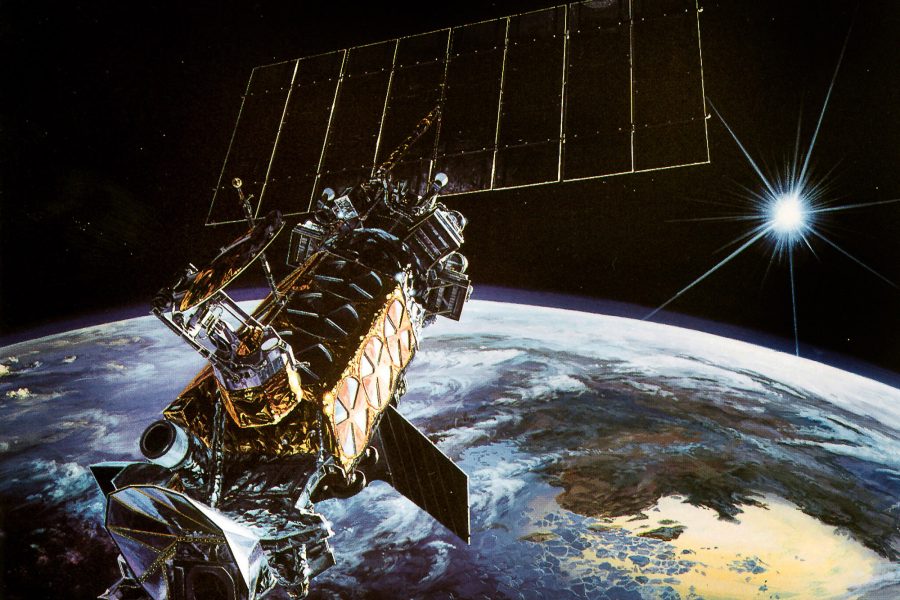Military missions in the air, on land, and at sea demand robust, timely weather information. On-orbit space-based environmental monitoring (SBEM) systems are a critical source of this data, but years of underfunding, delayed, curtailed, and canceled modernization programs have left the SBEM enterprise in a precarious state.
The Defense Meteorological Satellite Program (DMSP) is the heart of the Defense Department’s owned and operated SBEM enterprise and is rapidly nearing the end of its operational life. These satellites must be replaced as soon as possible.
Fortunately, the Pentagon has replacement systems in the works: Electro-Optical/Infrared (EO/IR) Weather System (EWS) and Weather System Follow-on – Microwave (WSF-M) must both remain on track. That includes funding, schedule, and operational fielding. Congress and the Space Force must ensure a newly announced study to evaluate the role of commercial satellite data in SBEM modernization does not delay or negatively impact these programs.
Commercial capabilities may well offer useful supplementary value, but those capabilities must not be conflated with systems that the military directly controls and that are engineered for specific warfighter requirements. There is simply no commercial solution that answers the full breadth of military needs.
Given these circumstances, there are several factors the Space Force needs to consider as it charts its forward vector for this crucial mission.
First, any use of commercial services must be recognized as supplemental to military capabilities. Congress and the DOD must ensure nothing prevents or delays the EWS and WSF-M programs, which are slated to replace DMSP.
These two systems represent the core defense-owned capabilities Space Force is fielding to execute key elements of the future SBEM mission. Attributes like assured control, operational security, plus military-specific accuracy, data type, and timeliness are crucial to joint operations. Also, in an era of increasing adversary threats, organic Space Force solutions are more likely to be designed to withstand attack, whether to the satellite, ground stations, or links.
The value of having assured access to DOD-owned and -operated SBEM capabilities cannot be overstated. The warfighter cannot risk a commercial provider imposing policies or politics that limit how their systems might be used in combat or whether they can be used in a particular conflict. As we’ve seen with Starlink in Ukraine, there are significant consequences to not having a clear understanding and commitment between the service provider and end-user prior to a system’s use in contested environments. For these reasons, the future SBEM architecture must, at its core, consist of dedicated military solutions.
Consider this air domain example: Although the Air Force has access to the commercial Air Reserve Force for additive airlift, that does not negate the need for a robust fleet of military airlifters for missions in higher-threat environments and unique operational conditions. The same holds true in space. EWS and WSF-M represent the direct, essential hand-off as DMSP nears retirement.
Second, the Space Force must build in resiliency into its SBEM architecture. That is why the service is disaggregating mission functions that currently reside on DMSP. DOD can add additional resilience by proliferating EWS and WSF-M past their initial buys. The inclusion of commercial and partner services as part of the SBEM hybrid architecture may also support this objective through diversification.
Third, the Space Force should continue to update SBEM requirements to reflect the future Combined Joint All Domain Command and Control (CJADC2) concept. This ties back to the points on unique military requirements, but also expands that discussion for the coverage and revisit rate needed to enable delivery of continuous cross-domain effects associated with CJADC2. Similar to resiliency, this will necessitate additional EWS and WSF-M satellites as part of a proliferated constellation.
Fourth, the Space Force must establish a long-term, stable SBEM program of record. The upcoming commercial study and reverse industry day will undoubtedly shed light on the extent commercial services can support the SBEM architecture. However, no one should be under the false belief that commercial capabilities can replace the defense-owned SBEM constellation. As EWS and WSF-M systems are fielded, the Space Force will gain needed insight into their performance and utility. This is precisely the informationthe service needs to make a significant decision about the future SBEM architecture and formally establish the needed program(s) of record.
Finally, the Space Force should build and mature its SBEM partnerships. Conducting the commercial study will naturally facilitate increased understanding and familiarity with the commercial providers to sow the seeds of future partnership. However, the existing partnerships with EWS and WSF-M contractors are also essential to cultivate. Maintaining clear communication on requirements, plans, and the final SBEM architecture is essential to ensuring the industrial base is informed and prepared to respond most appropriately and rapidly to support the DOD—especially given the need to grow the scale and scope of the SBEM enterprise.
The SBEM mission has traditionally struggled for the prioritization it deserves. The Space Force is now powerfully leading the way, but there remains the broader challenge facing the Space Force as it grapples with more mission than resources.
After years’ worth of delays to SBEM modernization and multiple proposed bridge solutions, the time is now to double down on this mission. DMSP is sunsetting after decades of outstanding performance. Military requirements must be met through a set of replacement systems that are specifically designed to meet warfighter requirements, are controlled by DOD, and can be scaled as requirements dictate. Partnerships with SBEM actors external to DOD can provide additive value but must not be confused as a direct replacement. Congress plays a key role in its oversight to ensure Guardians have the resources necessary to meet all the nation’s military space mission requirements. SBEM is a lynchpin capability. It must be prioritized as such.
